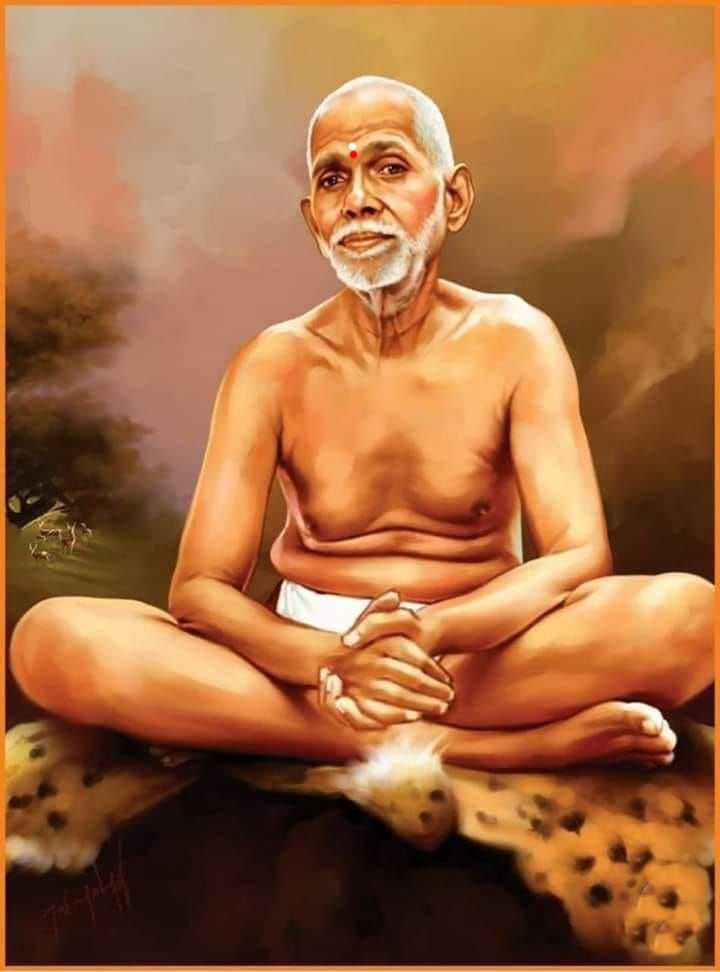Sri Ramana Maharshi: The Sage of Self-Realization
Overview: Sri Ramana Maharshi Biography
“7 Profound Lessons from Sri Ramana Maharshi Biography for Inner Peace” Sri Ramana Maharshi (1879–1950) was an Indian sage and philosopher renowned for his teachings on self-inquiry and self-realization. Residing primarily at the foot of Arunachala Hill in Tiruvannamalai, Tamil Nadu, Ramana’s life and teachings have profoundly influenced seekers of truth worldwide. His message, rooted in Advaita Vedanta, emphasizes the importance of understanding the true self to achieve liberation.
Sri Ramana Maharshi Biography
Born on December 30, 1879, as Venkataraman Iyer in a small village in Tamil Nadu, Ramana’s early life was unremarkable. However, at the age of 16, he experienced a profound spiritual awakening. Confronting the fear of death, he realized the eternal nature of the self (“Atman”). This transformative event marked the beginning of his journey as a spiritual guide.
Shortly after his awakening, Ramana left home and traveled to Arunachala, a sacred mountain he regarded as the embodiment of Lord Shiva. He spent years in deep meditation, often in solitude, gradually attracting followers drawn by his serene presence and profound wisdom.
Ramana never claimed to be a teacher or founded a formal school of thought. Instead, he lived a simple life at the ashram established near Arunachala, where seekers from around the globe came to sit in his presence and learn from his teachings.
He passed away on April 14, 1950, yet his teachings remain timeless and universally relevant.
Key Teachings: Sri Ramana Maharshi Biography
- Self-Inquiry (“Who am I?”): Ramana’s core teaching involves turning one’s attention inward to discover the true self, beyond the body and mind.
- Silence as a Teaching: He believed silence to be the purest form of teaching, transcending words and concepts.
- Non-Attachment: Ramana emphasized detachment from worldly desires as a path to liberation.
- Equality of All Religions: His teachings transcend sectarian boundaries, focusing on the universal quest for self-realization.
- The Illusion of the Ego: He taught that identifying with the ego is the root of suffering and that realizing the self dissolves this illusion.
Daily Life Impacts: Sri Ramana Maharshi Biography
Ramana Maharshi’s teachings provide practical guidance for leading a harmonious and spiritually fulfilling life:
- Inner Peace: His method of self-inquiry helps individuals transcend daily anxieties and find lasting peace.
- Mindfulness: Emphasizing presence and awareness, his teachings foster mindfulness in everyday activities.
- Universal Harmony: By transcending religious and cultural divides, Ramana’s philosophy promotes global unity.
Historical Significance: Sri Ramana Maharshi Biography
- Revival of Advaita Vedanta: Ramana Maharshi reintroduced the practice of self-inquiry as a direct means to self-realization.
- Global Influence: His teachings attracted notable Western philosophers, writers, and spiritual seekers, spreading Indian philosophy worldwide.
- Symbol of Simplicity: His life exemplifies humility, detachment, and unconditional love, inspiring countless individuals.
Lesser-Known Facts: Sri Ramana Maharshi Biography
- Early Renunciation: Ramana renounced his family and worldly ties at the age of 16.
- No Formal Education in Philosophy: Despite his profound insights, Ramana had no formal training in scriptures or philosophy.
- Natural Healer: Many devotees reported miraculous physical and emotional healings in his presence.
- Minimal Speech: He often communicated through silence or brief, impactful answers.
Frequently Asked Questions (FAQs): Sri Ramana Maharshi Biography
Q1: What is the essence of Ramana Maharshi’s teachings?
The essence lies in self-inquiry (“Who am I?”) to realize the eternal, true self.
Q2: Why is Arunachala significant to Ramana Maharshi?
He considered Arunachala a manifestation of Lord Shiva and the spiritual center of the universe.
Q3: Did Ramana advocate any specific religious practices?
No, he emphasized self-inquiry and self-awareness, transcending ritualistic practices.
Q4: How can one practice self-inquiry?
By persistently questioning the source of the ego and turning inward to experience the true self.
Significance: Sri Ramana Maharshi Biography
Sri Ramana’s teachings offer a path to liberation that is simple yet profound. In a world often driven by external pursuits, his emphasis on inner exploration remains relevant and transformative. His life serves as a testament to the possibility of achieving peace and freedom through self-realization.
Observance and Celebrations: Sri Ramana Maharshi Biography
- Jayanti: Ramana Maharshi’s birth anniversary is celebrated with prayers, meditation, and spiritual discourses.
- Aradhana Day: The day of his Maha Nirvana (liberation) is observed with devotion at the Ramanasramam in Tiruvannamalai.
Wishing for Ramana’s Values in Society
In a world filled with distractions and conflicts, Ramana Maharshi’s message of introspection, silence, and universal love provides a guiding light. His teachings encourage individuals to look within for solutions to personal and societal challenges.
Key Points at a Glance: Sri Ramana Maharshi Biography
- Born: December 30, 1879, in Tamil Nadu, India.
- Philosophy: Self-inquiry and non-dualism.
- Legacy: Revered as a modern-day sage and spiritual luminary.
- Milestone: Revival of direct paths to self-realization.
- Celebration: Birth and liberation anniversaries are observed with devotion.










